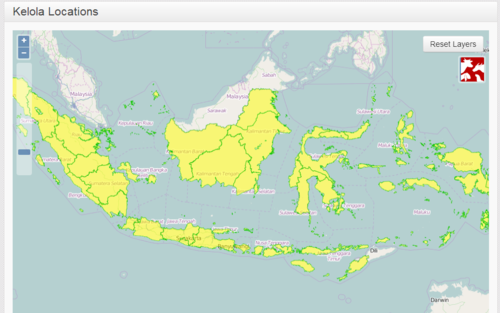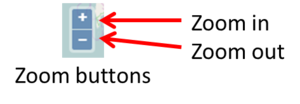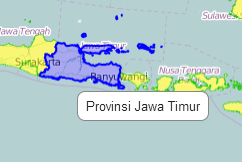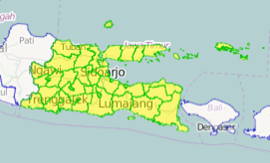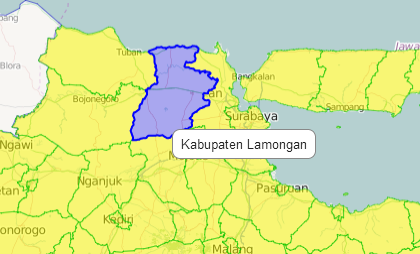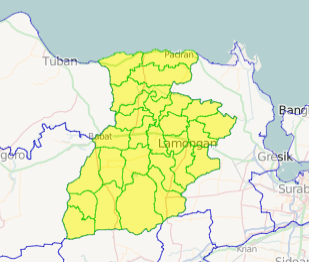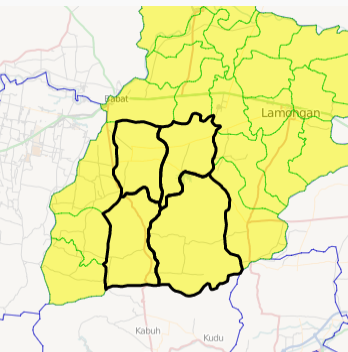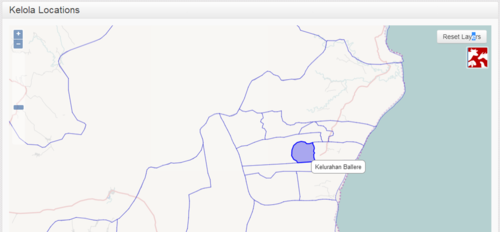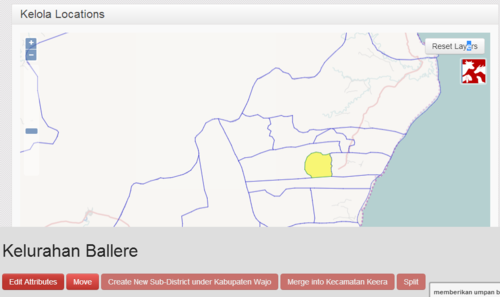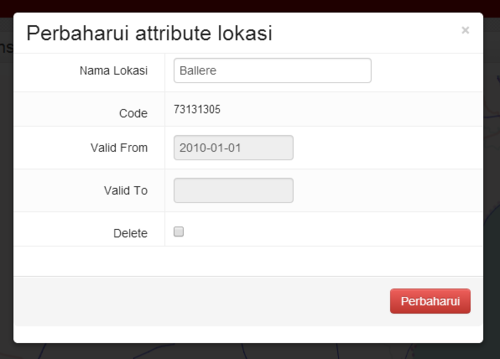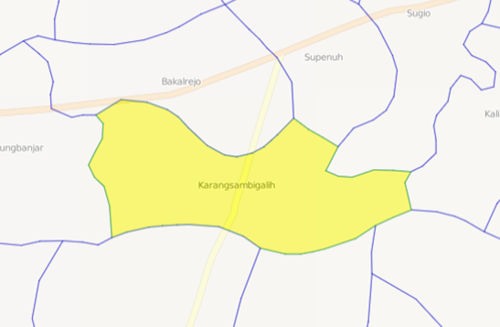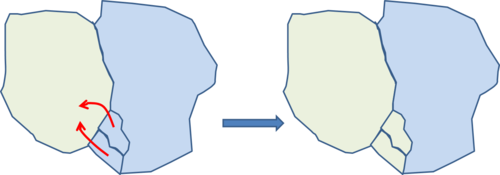Spatial data management manual: Perbedaan revisi
(Created page with "<languages/> <translate> ==Changing administrative boundaries : A guide for iSIKHNAS Coordinators== ===Background=== ==== Spatial data ==== Spatial data includes data about l...") |
(→Map interface - navigation) |
||
| Baris 57: | Baris 57: | ||
*Pan | *Pan | ||
** Click and drag | ** Click and drag | ||
| − | + | ||
*Zoom in | *Zoom in | ||
** Double click, or | ** Double click, or | ||
| − | ** Zoom slider, or | + | ** Zoom slider, or] |
** Zoom button | ** Zoom button | ||
| + | [[Image:Spatial_data_2.png|300px|centre] | ||
| + | |||
* Zoom out | * Zoom out | ||
**Zoom slider, or | **Zoom slider, or | ||
**Zoom button | **Zoom button | ||
| − | [[Image:Spatial_data_3.png| | + | [[Image:Spatial_data_3.png|300px|centre]] |
==== Selecting single units ==== | ==== Selecting single units ==== | ||
Revisi per 5 Mei 2015 16.52
Daftar isi
- 1 Changing administrative boundaries : A guide for iSIKHNAS Coordinators
Changing administrative boundaries : A guide for iSIKHNAS Coordinators
Background
Spatial data
Spatial data includes data about locations, names and boundaries of
- Desa
- Kecamatan
- Kabupaten
- Provinsi
Boundaries change
For example
- 1 desa split into two desa
- Kecamatan moved from one kabupaten to another
- Name of Kecamatan changed
- New province created out of kabupaten from another province
Importance of spatial data
In iSIKHNAS, all data is linked to a location. This allows
- Analysis
- Mapping
- Identifying area of responsibility
If location data is out of date
- Users cannot submit accurate data
The problem
Official national data from BPS
- Only updated annually
- Quickly out of date
The solution
The people that know about the changes first are the local staff
- iSIKHNAS coordinators
iSIKHNAS will offer a way for kabupaten and provincial coordinators to update any changes to the spatial data directly on the web
Advantages
- Coordinators can fix any problems immediately
- Data is always accurate, using local knowledge
- iSIKHNAS tracks changes in the names and boundaries over time
- Historical data is mapped with old maps
- New data is mapped with new maps
Overview
- Map interface – select the unit or units to change
- Click on the button for the change
- Provide details of changes
- Save changes
Map Interface
- Pan
- Click and drag
- Zoom in
- Double click, or
- Zoom slider, or]
- Zoom button
[[Image:Spatial_data_2.png|300px|centre]
- Zoom out
- Zoom slider, or
- Zoom button
Selecting single units
- Float over province to see the name
- It will be shown in blue
- Single click on a province to select
- It will be highlighted in yellow
- The kabupaten will be shown in green
- Zoom in to see districts better
- Float to see the name
- Blue highlight
- Single click to select
- Yellow highlight
- Kecamatan boundaries will be shown
Selecting multiple units
- Hold down shift key
- Click on the first unit
- Keep holding down the shift key
- Click on the second unit
- Repeat until all units are selected
- Release the shift key
- Selected units are outlined in black
Operations
Edit
- Change the name of a unit
Split
- Split one desa into two desa
Move
- Move a unit from one parent unit to another
Merge
- Merge two desa into a single desa
Create
- Create a new unit from several other sub-units
Edit
- This is used to change the name of a
- Desa
- Kecamatan
- Kabupaten
- Provinsi
1. Select the unit on the map interface
2. Click on the Edit button
3. Edit the name
Split
This is used when one desa is split to become two desa (a new and an old).
You need to mark the line of the new boundary between the two desa.
- Select a single desa
- Only desa can be split, not higher level units
- Zoom in so the desa fills most of the screen
- This will make it easier to edit
You now need to mark the line that divides the desa into two new desa.
- If available, copy this line from a map.
- The line may follow a river or a road – trace it on the map
- If you don’t know, you can draw a line in the middle of the desa where you estimate the boundary should be
- Try to be as accurate as possible, but don’t worry if the line not exactly right
- Click on the Split button
- With the mouse, single-click on a series of points that mark the new boundary to split the desa
- Start with the first point outside the desa
- Then single-click points close together along the line until you get to the other side of the desa
- Double-click the last point outside the desa to finish
- The system will ask you which is the new desa
- Click to select the new desa
- Edit the name and save
Move
- Move is used to move a unit from one parent unit to another
For example
- Move a desa to a different kecamatan
- Move a kecamatan to a different kabupaten
- Move a kabupaten to a different province
- The moved unit will get a new location code
- So will all sub-units (eg desa in a kecamatan)
- Select one or more units to be moved
- They must all be at the same level
- All kecamatan, or all desa
- They must all be in the same parent unit
- Kecamatan in the same kabupaten
- Desa in the same kecamatan
- They must all be at the same level
- Click on the Move button
Click on the unit to move to
- This must be a parent unit
- If you are moving desa, you must choose a kecamatan
- If you are moving kecamatan you must choose a kabupaten
- It must be next to the selected units
- It must have a common boundary
- Click OK
- The units will be given a new location code
- The boundaries of the parent and higher units will be recalculated
Merge
- Two desa are joined into a single desa
- Select the two desa to merge
- Only desa can be merged (not higher units)
- The desa must be next to each other (share a common border)
- Click on the Merge button
- Select the old desa with the name that will be kept for the new desa
- Click OK
Create
Creates a new higher-level unit from a collection of units For example
- A new province from one or more selected kabupaten
- A new kabupaten from one or more selected kecamatan
- Select one or more units
- They must all be at the same level
- They must all be next to each other
- Click Create
- Enter the name for the new parent unit

